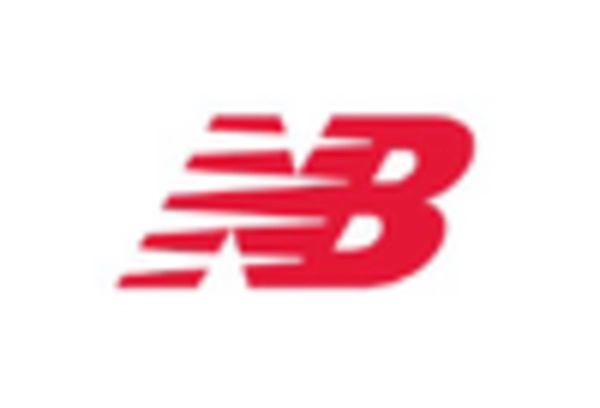-
EXECUTIVE SUMMARY
-
Market Overview
-
Key Findings
-
Market Segmentation
-
Competitive Landscape
-
Challenges and Opportunities
-
Future Outlook
-
MARKET INTRODUCTION
-
Definition
-
Scope of the study
- Research Objective
- Assumption
- Limitations
-
RESEARCH METHODOLOGY
-
Overview
-
Data Mining
-
Secondary Research
-
Primary Research
- Primary Interviews and Information Gathering Process
- Breakdown of Primary Respondents
-
Forecasting Model
-
Market Size Estimation
- Bottom-Up Approach
- Top-Down Approach
-
Data Triangulation
-
Validation
-
MARKET DYNAMICS
-
Overview
-
Drivers
-
Restraints
-
Opportunities
-
MARKET FACTOR ANALYSIS
-
Value chain Analysis
-
Porter's Five Forces Analysis
- Bargaining Power of Suppliers
- Bargaining Power of Buyers
- Threat of New Entrants
- Threat of Substitutes
- Intensity of Rivalry
-
COVID-19 Impact Analysis
- Market Impact Analysis
- Regional Impact
- Opportunity and Threat Analysis
-
Sports Technology Market, BY Technology (USD Billion)
-
Devices
-
Smart Stadium
-
Analytic & Statistics
-
E-sports
-
Sports Technology Market, BY Sports Type (USD Billion)
-
Soccer
-
Basketball
-
Cricket
-
Tennis
-
Ice Hockey
-
Rugby
-
Baseball
-
Sports Technology Market, BY Regional (USD Billion)
-
North America
- US
- Canada
-
Europe
- Germany
- UK
- France
- Russia
- Italy
- Spain
- Rest of Europe
-
APAC
- China
- India
- Japan
- South Korea
- Malaysia
- Thailand
- Indonesia
- Rest of APAC
-
South America
- Brazil
- Mexico
- Argentina
- Rest of South America
-
MEA
- GCC Countries
- South Africa
- Rest of MEA
-
Competitive Landscape
-
Overview
-
Competitive Analysis
-
Market share Analysis
-
Major Growth Strategy in the Sports Technology Market
-
Competitive Benchmarking
-
Leading Players in Terms of Number of Developments in the Sports Technology Market
-
Key developments and growth strategies
- New Product Launch/Service Deployment
- Merger & Acquisitions
- Joint Ventures
-
Major Players Financial Matrix
- Sales and Operating Income
- Major Players R&D Expenditure. 2023
-
Company Profiles
-
Catapult Sports
- Financial Overview
- Products Offered
- Key Developments
- SWOT Analysis
- Key Strategies
-
PlaySight
- Financial Overview
- Products Offered
- Key Developments
- SWOT Analysis
- Key Strategies
-
Whoop
- Financial Overview
- Products Offered
- Key Developments
- SWOT Analysis
- Key Strategies
-
Pioneer Athletics
- Financial Overview
- Products Offered
- Key Developments
- SWOT Analysis
- Key Strategies
-
Nielsen
- Financial Overview
- Products Offered
- Key Developments
- SWOT Analysis
- Key Strategies
-
IBM
- Financial Overview
- Products Offered
- Key Developments
- SWOT Analysis
- Key Strategies
-
Kawasaki Heavy Industries
- Financial Overview
- Products Offered
- Key Developments
- SWOT Analysis
- Key Strategies
-
Intel
- Financial Overview
- Products Offered
- Key Developments
- SWOT Analysis
- Key Strategies
-
HawkEye Innovations
- Financial Overview
- Products Offered
- Key Developments
- SWOT Analysis
- Key Strategies
-
Wearable X
- Financial Overview
- Products Offered
- Key Developments
- SWOT Analysis
- Key Strategies
-
Zebra Technologies
- Financial Overview
- Products Offered
- Key Developments
- SWOT Analysis
- Key Strategies
-
SAP
- Financial Overview
- Products Offered
- Key Developments
- SWOT Analysis
- Key Strategies
-
SportRadar
- Financial Overview
- Products Offered
- Key Developments
- SWOT Analysis
- Key Strategies
-
STATS Perform
- Financial Overview
- Products Offered
- Key Developments
- SWOT Analysis
- Key Strategies
-
Opta Sports
- Financial Overview
- Products Offered
- Key Developments
- SWOT Analysis
- Key Strategies
-
Appendix
-
References
-
Related Reports
-
LIST Of tables
-
LIST OF ASSUMPTIONS
-
North America Sports Technology Market SIZE ESTIMATES & FORECAST, BY TECHNOLOGY, 2019-2035 (USD Billions)
-
North America Sports Technology Market SIZE ESTIMATES & FORECAST, BY SPORTS TYPE, 2019-2035 (USD Billions)
-
North America Sports Technology Market SIZE ESTIMATES & FORECAST, BY REGIONAL, 2019-2035 (USD Billions)
-
US Sports Technology Market SIZE ESTIMATES & FORECAST, BY TECHNOLOGY, 2019-2035 (USD Billions)
-
US Sports Technology Market SIZE ESTIMATES & FORECAST, BY SPORTS TYPE, 2019-2035 (USD Billions)
-
US Sports Technology Market SIZE ESTIMATES & FORECAST, BY REGIONAL, 2019-2035 (USD Billions)
-
Canada Sports Technology Market SIZE ESTIMATES & FORECAST, BY TECHNOLOGY, 2019-2035 (USD Billions)
-
Canada Sports Technology Market SIZE ESTIMATES & FORECAST, BY SPORTS TYPE, 2019-2035 (USD Billions)
-
Canada Sports Technology Market SIZE ESTIMATES & FORECAST, BY REGIONAL, 2019-2035 (USD Billions)
-
Europe Sports Technology Market SIZE ESTIMATES & FORECAST, BY TECHNOLOGY, 2019-2035 (USD Billions)
-
Europe Sports Technology Market SIZE ESTIMATES & FORECAST, BY SPORTS TYPE, 2019-2035 (USD Billions)
-
Europe Sports Technology Market SIZE ESTIMATES & FORECAST, BY REGIONAL, 2019-2035 (USD Billions)
-
Germany Sports Technology Market SIZE ESTIMATES & FORECAST, BY TECHNOLOGY, 2019-2035 (USD Billions)
-
Germany Sports Technology Market SIZE ESTIMATES & FORECAST, BY SPORTS TYPE, 2019-2035 (USD Billions)
-
Germany Sports Technology Market SIZE ESTIMATES & FORECAST, BY REGIONAL, 2019-2035 (USD Billions)
-
UK Sports Technology Market SIZE ESTIMATES & FORECAST, BY TECHNOLOGY, 2019-2035 (USD Billions)
-
UK Sports Technology Market SIZE ESTIMATES & FORECAST, BY SPORTS TYPE, 2019-2035 (USD Billions)
-
UK Sports Technology Market SIZE ESTIMATES & FORECAST, BY REGIONAL, 2019-2035 (USD Billions)
-
France Sports Technology Market SIZE ESTIMATES & FORECAST, BY TECHNOLOGY, 2019-2035 (USD Billions)
-
France Sports Technology Market SIZE ESTIMATES & FORECAST, BY SPORTS TYPE, 2019-2035 (USD Billions)
-
France Sports Technology Market SIZE ESTIMATES & FORECAST, BY REGIONAL, 2019-2035 (USD Billions)
-
Russia Sports Technology Market SIZE ESTIMATES & FORECAST, BY TECHNOLOGY, 2019-2035 (USD Billions)
-
Russia Sports Technology Market SIZE ESTIMATES & FORECAST, BY SPORTS TYPE, 2019-2035 (USD Billions)
-
Russia Sports Technology Market SIZE ESTIMATES & FORECAST, BY REGIONAL, 2019-2035 (USD Billions)
-
Italy Sports Technology Market SIZE ESTIMATES & FORECAST, BY TECHNOLOGY, 2019-2035 (USD Billions)
-
Italy Sports Technology Market SIZE ESTIMATES & FORECAST, BY SPORTS TYPE, 2019-2035 (USD Billions)
-
Italy Sports Technology Market SIZE ESTIMATES & FORECAST, BY REGIONAL, 2019-2035 (USD Billions)
-
Spain Sports Technology Market SIZE ESTIMATES & FORECAST, BY TECHNOLOGY, 2019-2035 (USD Billions)
-
Spain Sports Technology Market SIZE ESTIMATES & FORECAST, BY SPORTS TYPE, 2019-2035 (USD Billions)
-
Spain Sports Technology Market SIZE ESTIMATES & FORECAST, BY REGIONAL, 2019-2035 (USD Billions)
-
Rest of Europe Sports Technology Market SIZE ESTIMATES & FORECAST, BY TECHNOLOGY, 2019-2035 (USD Billions)
-
Rest of Europe Sports Technology Market SIZE ESTIMATES & FORECAST, BY SPORTS TYPE, 2019-2035 (USD Billions)
-
Rest of Europe Sports Technology Market SIZE ESTIMATES & FORECAST, BY REGIONAL, 2019-2035 (USD Billions)
-
APAC Sports Technology Market SIZE ESTIMATES & FORECAST, BY TECHNOLOGY, 2019-2035 (USD Billions)
-
APAC Sports Technology Market SIZE ESTIMATES & FORECAST, BY SPORTS TYPE, 2019-2035 (USD Billions)
-
APAC Sports Technology Market SIZE ESTIMATES & FORECAST, BY REGIONAL, 2019-2035 (USD Billions)
-
China Sports Technology Market SIZE ESTIMATES & FORECAST, BY TECHNOLOGY, 2019-2035 (USD Billions)
-
China Sports Technology Market SIZE ESTIMATES & FORECAST, BY SPORTS TYPE, 2019-2035 (USD Billions)
-
China Sports Technology Market SIZE ESTIMATES & FORECAST, BY REGIONAL, 2019-2035 (USD Billions)
-
India Sports Technology Market SIZE ESTIMATES & FORECAST, BY TECHNOLOGY, 2019-2035 (USD Billions)
-
India Sports Technology Market SIZE ESTIMATES & FORECAST, BY SPORTS TYPE, 2019-2035 (USD Billions)
-
India Sports Technology Market SIZE ESTIMATES & FORECAST, BY REGIONAL, 2019-2035 (USD Billions)
-
Japan Sports Technology Market SIZE ESTIMATES & FORECAST, BY TECHNOLOGY, 2019-2035 (USD Billions)
-
Japan Sports Technology Market SIZE ESTIMATES & FORECAST, BY SPORTS TYPE, 2019-2035 (USD Billions)
-
Japan Sports Technology Market SIZE ESTIMATES & FORECAST, BY REGIONAL, 2019-2035 (USD Billions)
-
South Korea Sports Technology Market SIZE ESTIMATES & FORECAST, BY TECHNOLOGY, 2019-2035 (USD Billions)
-
South Korea Sports Technology Market SIZE ESTIMATES & FORECAST, BY SPORTS TYPE, 2019-2035 (USD Billions)
-
South Korea Sports Technology Market SIZE ESTIMATES & FORECAST, BY REGIONAL, 2019-2035 (USD Billions)
-
Malaysia Sports Technology Market SIZE ESTIMATES & FORECAST, BY TECHNOLOGY, 2019-2035 (USD Billions)
-
Malaysia Sports Technology Market SIZE ESTIMATES & FORECAST, BY SPORTS TYPE, 2019-2035 (USD Billions)
-
Malaysia Sports Technology Market SIZE ESTIMATES & FORECAST, BY REGIONAL, 2019-2035 (USD Billions)
-
Thailand Sports Technology Market SIZE ESTIMATES & FORECAST, BY TECHNOLOGY, 2019-2035 (USD Billions)
-
Thailand Sports Technology Market SIZE ESTIMATES & FORECAST, BY SPORTS TYPE, 2019-2035 (USD Billions)
-
Thailand Sports Technology Market SIZE ESTIMATES & FORECAST, BY REGIONAL, 2019-2035 (USD Billions)
-
Indonesia Sports Technology Market SIZE ESTIMATES & FORECAST, BY TECHNOLOGY, 2019-2035 (USD Billions)
-
Indonesia Sports Technology Market SIZE ESTIMATES & FORECAST, BY SPORTS TYPE, 2019-2035 (USD Billions)
-
Indonesia Sports Technology Market SIZE ESTIMATES & FORECAST, BY REGIONAL, 2019-2035 (USD Billions)
-
Rest of APAC Sports Technology Market SIZE ESTIMATES & FORECAST, BY TECHNOLOGY, 2019-2035 (USD Billions)
-
Rest of APAC Sports Technology Market SIZE ESTIMATES & FORECAST, BY SPORTS TYPE, 2019-2035 (USD Billions)
-
Rest of APAC Sports Technology Market SIZE ESTIMATES & FORECAST, BY REGIONAL, 2019-2035 (USD Billions)
-
South America Sports Technology Market SIZE ESTIMATES & FORECAST, BY TECHNOLOGY, 2019-2035 (USD Billions)
-
South America Sports Technology Market SIZE ESTIMATES & FORECAST, BY SPORTS TYPE, 2019-2035 (USD Billions)
-
South America Sports Technology Market SIZE ESTIMATES & FORECAST, BY REGIONAL, 2019-2035 (USD Billions)
-
Brazil Sports Technology Market SIZE ESTIMATES & FORECAST, BY TECHNOLOGY, 2019-2035 (USD Billions)
-
Brazil Sports Technology Market SIZE ESTIMATES & FORECAST, BY SPORTS TYPE, 2019-2035 (USD Billions)
-
Brazil Sports Technology Market SIZE ESTIMATES & FORECAST, BY REGIONAL, 2019-2035 (USD Billions)
-
Mexico Sports Technology Market SIZE ESTIMATES & FORECAST, BY TECHNOLOGY, 2019-2035 (USD Billions)
-
Mexico Sports Technology Market SIZE ESTIMATES & FORECAST, BY SPORTS TYPE, 2019-2035 (USD Billions)
-
Mexico Sports Technology Market SIZE ESTIMATES & FORECAST, BY REGIONAL, 2019-2035 (USD Billions)
-
Argentina Sports Technology Market SIZE ESTIMATES & FORECAST, BY TECHNOLOGY, 2019-2035 (USD Billions)
-
Argentina Sports Technology Market SIZE ESTIMATES & FORECAST, BY SPORTS TYPE, 2019-2035 (USD Billions)
-
Argentina Sports Technology Market SIZE ESTIMATES & FORECAST, BY REGIONAL, 2019-2035 (USD Billions)
-
Rest of South America Sports Technology Market SIZE ESTIMATES & FORECAST, BY TECHNOLOGY, 2019-2035 (USD Billions)
-
Rest of South America Sports Technology Market SIZE ESTIMATES & FORECAST, BY SPORTS TYPE, 2019-2035 (USD Billions)
-
Rest of South America Sports Technology Market SIZE ESTIMATES & FORECAST, BY REGIONAL, 2019-2035 (USD Billions)
-
MEA Sports Technology Market SIZE ESTIMATES & FORECAST, BY TECHNOLOGY, 2019-2035 (USD Billions)
-
MEA Sports Technology Market SIZE ESTIMATES & FORECAST, BY SPORTS TYPE, 2019-2035 (USD Billions)
-
MEA Sports Technology Market SIZE ESTIMATES & FORECAST, BY REGIONAL, 2019-2035 (USD Billions)
-
GCC Countries Sports Technology Market SIZE ESTIMATES & FORECAST, BY TECHNOLOGY, 2019-2035 (USD Billions)
-
GCC Countries Sports Technology Market SIZE ESTIMATES & FORECAST, BY SPORTS TYPE, 2019-2035 (USD Billions)
-
GCC Countries Sports Technology Market SIZE ESTIMATES & FORECAST, BY REGIONAL, 2019-2035 (USD Billions)
-
South Africa Sports Technology Market SIZE ESTIMATES & FORECAST, BY TECHNOLOGY, 2019-2035 (USD Billions)
-
South Africa Sports Technology Market SIZE ESTIMATES & FORECAST, BY SPORTS TYPE, 2019-2035 (USD Billions)
-
South Africa Sports Technology Market SIZE ESTIMATES & FORECAST, BY REGIONAL, 2019-2035 (USD Billions)
-
Rest of MEA Sports Technology Market SIZE ESTIMATES & FORECAST, BY TECHNOLOGY, 2019-2035 (USD Billions)
-
Rest of MEA Sports Technology Market SIZE ESTIMATES & FORECAST, BY SPORTS TYPE, 2019-2035 (USD Billions)
-
Rest of MEA Sports Technology Market SIZE ESTIMATES & FORECAST, BY REGIONAL, 2019-2035 (USD Billions)
-
PRODUCT LAUNCH/PRODUCT DEVELOPMENT/APPROVAL
-
ACQUISITION/PARTNERSHIP
-
LIST Of figures
-
MARKET SYNOPSIS
-
NORTH AMERICA SPORTS TECHNOLOGY MARKET ANALYSIS
-
US SPORTS TECHNOLOGY MARKET ANALYSIS BY TECHNOLOGY
-
US SPORTS TECHNOLOGY MARKET ANALYSIS BY SPORTS TYPE
-
US SPORTS TECHNOLOGY MARKET ANALYSIS BY REGIONAL
-
CANADA SPORTS TECHNOLOGY MARKET ANALYSIS BY TECHNOLOGY
-
CANADA SPORTS TECHNOLOGY MARKET ANALYSIS BY SPORTS TYPE
-
CANADA SPORTS TECHNOLOGY MARKET ANALYSIS BY REGIONAL
-
EUROPE SPORTS TECHNOLOGY MARKET ANALYSIS
-
GERMANY SPORTS TECHNOLOGY MARKET ANALYSIS BY TECHNOLOGY
-
GERMANY SPORTS TECHNOLOGY MARKET ANALYSIS BY SPORTS TYPE
-
GERMANY SPORTS TECHNOLOGY MARKET ANALYSIS BY REGIONAL
-
UK SPORTS TECHNOLOGY MARKET ANALYSIS BY TECHNOLOGY
-
UK SPORTS TECHNOLOGY MARKET ANALYSIS BY SPORTS TYPE
-
UK SPORTS TECHNOLOGY MARKET ANALYSIS BY REGIONAL
-
FRANCE SPORTS TECHNOLOGY MARKET ANALYSIS BY TECHNOLOGY
-
FRANCE SPORTS TECHNOLOGY MARKET ANALYSIS BY SPORTS TYPE
-
FRANCE SPORTS TECHNOLOGY MARKET ANALYSIS BY REGIONAL
-
RUSSIA SPORTS TECHNOLOGY MARKET ANALYSIS BY TECHNOLOGY
-
RUSSIA SPORTS TECHNOLOGY MARKET ANALYSIS BY SPORTS TYPE
-
RUSSIA SPORTS TECHNOLOGY MARKET ANALYSIS BY REGIONAL
-
ITALY SPORTS TECHNOLOGY MARKET ANALYSIS BY TECHNOLOGY
-
ITALY SPORTS TECHNOLOGY MARKET ANALYSIS BY SPORTS TYPE
-
ITALY SPORTS TECHNOLOGY MARKET ANALYSIS BY REGIONAL
-
SPAIN SPORTS TECHNOLOGY MARKET ANALYSIS BY TECHNOLOGY
-
SPAIN SPORTS TECHNOLOGY MARKET ANALYSIS BY SPORTS TYPE
-
SPAIN SPORTS TECHNOLOGY MARKET ANALYSIS BY REGIONAL
-
REST OF EUROPE SPORTS TECHNOLOGY MARKET ANALYSIS BY TECHNOLOGY
-
REST OF EUROPE SPORTS TECHNOLOGY MARKET ANALYSIS BY SPORTS TYPE
-
REST OF EUROPE SPORTS TECHNOLOGY MARKET ANALYSIS BY REGIONAL
-
APAC SPORTS TECHNOLOGY MARKET ANALYSIS
-
CHINA SPORTS TECHNOLOGY MARKET ANALYSIS BY TECHNOLOGY
-
CHINA SPORTS TECHNOLOGY MARKET ANALYSIS BY SPORTS TYPE
-
CHINA SPORTS TECHNOLOGY MARKET ANALYSIS BY REGIONAL
-
INDIA SPORTS TECHNOLOGY MARKET ANALYSIS BY TECHNOLOGY
-
INDIA SPORTS TECHNOLOGY MARKET ANALYSIS BY SPORTS TYPE
-
INDIA SPORTS TECHNOLOGY MARKET ANALYSIS BY REGIONAL
-
JAPAN SPORTS TECHNOLOGY MARKET ANALYSIS BY TECHNOLOGY
-
JAPAN SPORTS TECHNOLOGY MARKET ANALYSIS BY SPORTS TYPE
-
JAPAN SPORTS TECHNOLOGY MARKET ANALYSIS BY REGIONAL
-
SOUTH KOREA SPORTS TECHNOLOGY MARKET ANALYSIS BY TECHNOLOGY
-
SOUTH KOREA SPORTS TECHNOLOGY MARKET ANALYSIS BY SPORTS TYPE
-
SOUTH KOREA SPORTS TECHNOLOGY MARKET ANALYSIS BY REGIONAL
-
MALAYSIA SPORTS TECHNOLOGY MARKET ANALYSIS BY TECHNOLOGY
-
MALAYSIA SPORTS TECHNOLOGY MARKET ANALYSIS BY SPORTS TYPE
-
MALAYSIA SPORTS TECHNOLOGY MARKET ANALYSIS BY REGIONAL
-
THAILAND SPORTS TECHNOLOGY MARKET ANALYSIS BY TECHNOLOGY
-
THAILAND SPORTS TECHNOLOGY MARKET ANALYSIS BY SPORTS TYPE
-
THAILAND SPORTS TECHNOLOGY MARKET ANALYSIS BY REGIONAL
-
INDONESIA SPORTS TECHNOLOGY MARKET ANALYSIS BY TECHNOLOGY
-
INDONESIA SPORTS TECHNOLOGY MARKET ANALYSIS BY SPORTS TYPE
-
INDONESIA SPORTS TECHNOLOGY MARKET ANALYSIS BY REGIONAL
-
REST OF APAC SPORTS TECHNOLOGY MARKET ANALYSIS BY TECHNOLOGY
-
REST OF APAC SPORTS TECHNOLOGY MARKET ANALYSIS BY SPORTS TYPE
-
REST OF APAC SPORTS TECHNOLOGY MARKET ANALYSIS BY REGIONAL
-
SOUTH AMERICA SPORTS TECHNOLOGY MARKET ANALYSIS
-
BRAZIL SPORTS TECHNOLOGY MARKET ANALYSIS BY TECHNOLOGY
-
BRAZIL SPORTS TECHNOLOGY MARKET ANALYSIS BY SPORTS TYPE
-
BRAZIL SPORTS TECHNOLOGY MARKET ANALYSIS BY REGIONAL
-
MEXICO SPORTS TECHNOLOGY MARKET ANALYSIS BY TECHNOLOGY
-
MEXICO SPORTS TECHNOLOGY MARKET ANALYSIS BY SPORTS TYPE
-
MEXICO SPORTS TECHNOLOGY MARKET ANALYSIS BY REGIONAL
-
ARGENTINA SPORTS TECHNOLOGY MARKET ANALYSIS BY TECHNOLOGY
-
ARGENTINA SPORTS TECHNOLOGY MARKET ANALYSIS BY SPORTS TYPE
-
ARGENTINA SPORTS TECHNOLOGY MARKET ANALYSIS BY REGIONAL
-
REST OF SOUTH AMERICA SPORTS TECHNOLOGY MARKET ANALYSIS BY TECHNOLOGY
-
REST OF SOUTH AMERICA SPORTS TECHNOLOGY MARKET ANALYSIS BY SPORTS TYPE
-
REST OF SOUTH AMERICA SPORTS TECHNOLOGY MARKET ANALYSIS BY REGIONAL
-
MEA SPORTS TECHNOLOGY MARKET ANALYSIS
-
GCC COUNTRIES SPORTS TECHNOLOGY MARKET ANALYSIS BY TECHNOLOGY
-
GCC COUNTRIES SPORTS TECHNOLOGY MARKET ANALYSIS BY SPORTS TYPE
-
GCC COUNTRIES SPORTS TECHNOLOGY MARKET ANALYSIS BY REGIONAL
-
SOUTH AFRICA SPORTS TECHNOLOGY MARKET ANALYSIS BY TECHNOLOGY
-
SOUTH AFRICA SPORTS TECHNOLOGY MARKET ANALYSIS BY SPORTS TYPE
-
SOUTH AFRICA SPORTS TECHNOLOGY MARKET ANALYSIS BY REGIONAL
-
REST OF MEA SPORTS TECHNOLOGY MARKET ANALYSIS BY TECHNOLOGY
-
REST OF MEA SPORTS TECHNOLOGY MARKET ANALYSIS BY SPORTS TYPE
-
REST OF MEA SPORTS TECHNOLOGY MARKET ANALYSIS BY REGIONAL
-
KEY BUYING CRITERIA OF SPORTS TECHNOLOGY MARKET
-
RESEARCH PROCESS OF MRFR
-
DRO ANALYSIS OF SPORTS TECHNOLOGY MARKET
-
DRIVERS IMPACT ANALYSIS: SPORTS TECHNOLOGY MARKET
-
RESTRAINTS IMPACT ANALYSIS: SPORTS TECHNOLOGY MARKET
-
SUPPLY / VALUE CHAIN: SPORTS TECHNOLOGY MARKET
-
SPORTS TECHNOLOGY MARKET, BY TECHNOLOGY, 2025 (% SHARE)
-
SPORTS TECHNOLOGY MARKET, BY TECHNOLOGY, 2019 TO 2035 (USD Billions)
-
SPORTS TECHNOLOGY MARKET, BY SPORTS TYPE, 2025 (% SHARE)
-
SPORTS TECHNOLOGY MARKET, BY SPORTS TYPE, 2019 TO 2035 (USD Billions)
-
SPORTS TECHNOLOGY MARKET, BY REGIONAL, 2025 (% SHARE)
-
SPORTS TECHNOLOGY MARKET, BY REGIONAL, 2019 TO 2035 (USD Billions)
-
BENCHMARKING OF MAJOR COMPETITORS
-
"
















Leave a Comment